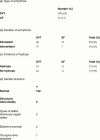Fetal tachycardias: management and outcome of 127 consecutive cases
- PMID: 10078084
- PMCID: PMC1728723
Fetal tachycardias: management and outcome of 127 consecutive cases
Abstract
Objective: To review the management and outcome of fetal tachycardia, and to determine the problems encountered with various treatment protocols.
Study design: Retrospective analysis.
Subjects: 127 consecutive fetuses with a tachycardia presenting between 1980 and 1996 to a single tertiary centre for fetal cardiology. The median gestational age at presentation was 32 weeks (range 18 to 42).
Results: 105 fetuses had a supraventricular tachycardia and 22 had atrial flutter. Overall, 52 fetuses were hydropic and 75 non-hydropic. Prenatal control of the tachycardia was achieved in 83% of treated non-hydropic fetuses compared with 66% of the treated hydropic fetuses. Digoxin monotherapy converted most (62%) of the treated non-hydropic fetuses, and 96% survived through the neonatal period. First line drug treatment for hydropic fetuses was more diverse, including digoxin (n = 5), digoxin plus verapamil (n = 14), and flecainide (n = 27). The response rates to these drugs were 20%, 57%, and 59%, respectively, confirming that digoxin monotherapy is a poor choice for the hydropic fetus. Response to flecainide was faster than to the other drugs. Direct fetal treatment was used in four fetuses, of whom two survived. Overall, 73% (n = 38) of the hydropic fetuses survived. Postnatally, 4% of the non-hydropic group had ECG evidence of pre-excitation, compared with 16% of the hydropic group; 57% of non-hydropic fetuses were treated with long term anti-arrhythmics compared with 79% of hydropic fetuses.
Conclusions: Non-hydropic fetuses with tachycardias have a very good prognosis with transplacental treatment. Most arrhythmias associated with fetal hydrops can be controlled with transplacental treatment, but the mortality in this group is 27%. At present, there is no ideal treatment protocol for these fetuses and a large prospective multicentre trial is required to optimise treatment of both hydropic and non-hydropic fetuses.
Figures



References
MeSH terms
Substances
LinkOut - more resources
Full Text Sources
